The first board with the X38 chipset in our labs did well. Of course, you can't expect any speed improvements because it's basically a P35 chipset, but with an additional 400MHz FSB strap. This means it supports 400MHz FSB (1600MHz marketing speech) out of the box and with higher FSBs you don't need the highest overclockable memory modules available to achieve nice overclocks. Of course, this is a feature unsupported by Intel. New features are 2x PCIe 2.0 x16 support for the latest graphics-cards and ECC support for DDR2 or DDR3 memory.
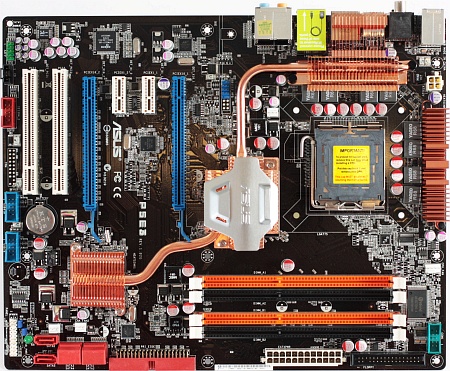
Features:
Intel X38/iCH9R
8-phase VRM
agere L-FW3227-100
Realtek ALC883
Marvell 88E8056 PCIe network MAC
Marvell 88SE6111 SATA II RAID 0, 1/IDE controller
Winbond W83627DHG-A Super I/O controller
ICS9LPRS918HKL clock generator
passive cooling of chipsets/VRM
8Mb BIOS, version 0703
Mainboard Revision: 1.02G
Slots:
2x PCIe 2.0 x16 (graphic cards only!)
2x PCIe x1
2x PCI
Memory:
2x Dual-Channel DDR3-slots for PC2-8500U memory up to 8GB
Storage:
6-Port SATA II featuring RAID 0, 1, 5, 0+1, JBOD
1-Port IDE
2-Port eSATA II
Backpanel ports:
1x PS/2 keyboard
2x eSATA II
1x Gb LAN
1x Firewire
6x USB 2.0
7.1 analog output
1x SP/DIF digital out
1x SP/DIF coaxial out

Accessories:
1x 2-port USB + 1-port Firewire bracket
6x SATA cable (3 angeled 90°)
1x HDD-power to 2x SATA power cable
1x Floppy cable
1x IDE cable
1x ASUS Q-Connetor Pack
1x additional fan
1x ASUS IR to USB connector
1x ASUS IR remote
BIOS features:
Bus Speeds: Auto, 200MHz to 800MHz in 1MHz increments
Memory Ratios: Auto, fixed ratios: 1:1, 1:1.2, 1:1.25, 1.66, 1:2 depending on FSB/strap
FSB Strap: Auto, 200MHz, 266MHz, 333MHz, 400MHz
DRAM command rate: Auto, 1T, 2T
DRAM timing control: Auto, manual
PCIe Frequency: Auto, 100 to 150 MHz in 1MHz increments
Transaction Booster: Auto, disable (relax 1-8) , enable (boost 1-8)
CPU Clock Multiplier: Auto, manual
Core 2 Duo: 6x-11x in 1X increments - Core 2 Duo, downwards unlocked
Core 2 Extreme: 6x-16X, downwards unlocked
CPU Voltage: auto, 0.8500V to 1.7000V in 0.00625V increments
CPU Voltage Reference: Auto, 0.531x, 0.541x, 0.561x, 0.761x, 0.581x, 0.597x, 0.618x, 0.635x
Loadline calibration: Auto, disable, enable
CPU PLL Voltage: Auto, 1.50V to 2.78V in 0.02V increments
DRAM Voltage: Auto, 1.50V to 2.30V in 0.02V increments
FSB Termination Voltage: Auto, 1.20V to 1.50V in 0.02V increments
North Bridge Voltage: Auto, 1.25V to 1.75V in 0.02V increments
North Bridge Voltage Reference: Auto, 0.67x, 0.61x
South Bridge Voltage: Auto, 1.050V to 1.225V in 0.025V increments
Layout:
ASUS did a nice job with the layout. On all ASUS boards we have tested so far, ASUS used an 8-pol EPS CPU-power connector. This time they stuck with an standard "P4" 4-pol 12V connector, which is a drawback when huge loads are required, such as quad-core CPUs not based on Penryn and high CPU overclocks. We would also like to swap the position of the connector with the CPU-fan connector, because this would avoid some of the cable mess in small cases.
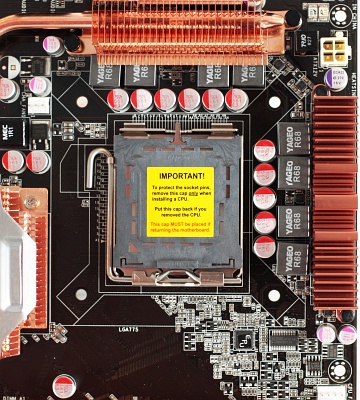
The VRM is an analog 8-phase design, compared to the P5K and Blitz series ASUS enhanced the design, which yields in lower power-consumption. The heatpipe keeps the temperatures in safe limits all times. Due the height of the Northbridge-Cooler this board has limited compatibility to some CPU-coolers. We could not install our Scythe reference cooler the way it was supposed to be installed, we needed to rotate it 90° which yields a 2-3"C temperature increase. Check the Webpages of the cooler manufacture for compatiblity issues.
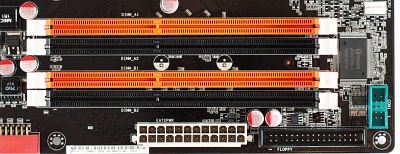
The memory slots are quite close to the primary PCIe x16 slot, so you need to fiddle with your modules when replacing them while a large graphics card is installed, but it's manageable. As usual, the 24-pin power and floppy connectors are located beneath.
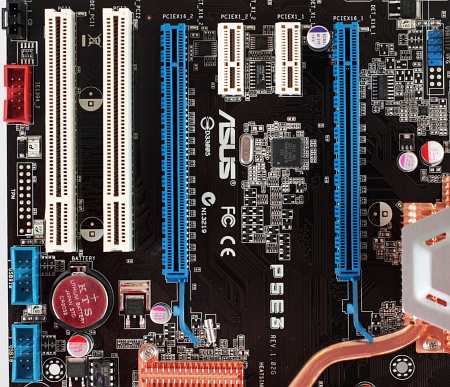
The slots are configurated okay, but not very well. The first drawback is that both PCIe x16 slots are only usable for x16 graphics cards; you can't install a PCIe x8 SATA RAID controller or a PCIe x1 TV-card. While high-end users will buy cards with dual-slot coolers or "silent" enthusiasts will swap the graphics card cooler for something better using 1.5 slots, the slots left from any PCIe x16 should be left "blank." One PCIe x1 slot would fit nicely between primary PCIe x16 slot and the heatpipe and any other slot should be PCI.
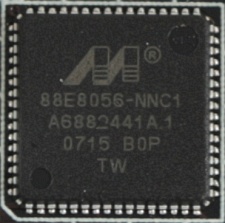
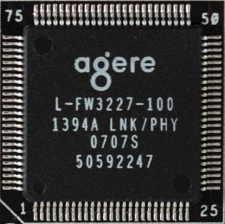
Network connectivity is provided by one Marvell PCIe chip, while an Agere chip provides two Firewire-slots, one on the back panel, one header on the board. Because this board is a "standard" edition, it doesn't feature a Supreme FX sound card nor an Analog Device soundchip onboard, so the ALC883 will have to do, or you can install an soundcard. The ICS clock generator is located between the PCIe x16 slots.
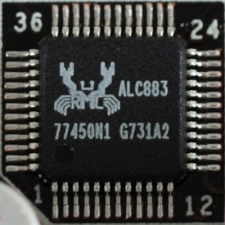
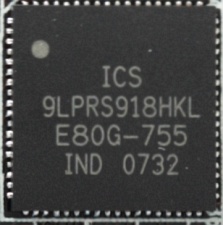
The SATA and PATA connectors are, as usual, on the left edge of the board. Four SATA connectors are angulated, so a second large graphics card will fit above them. This board does not feature sophisticated post diagnose. Only a big awful looking LED indicates that the mainboard is powered, and no more information while booting is available.
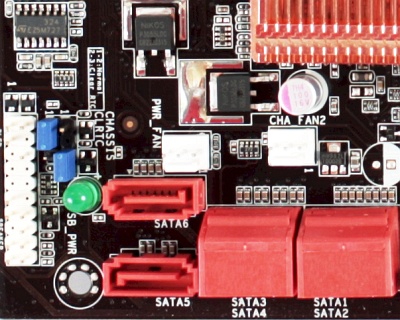

BIOS:
ASUS stuck with an AMI BIOS 1MB version. This BIOS does show you the SPD readings of your memory and some default timing values outside the SPD shown in order of the BIOS settings, which helps while overclocking. The most annoying feature of the ASUS BIOS is that while overclocked the CPU will not receive idle voltages. The CPU multiplicator is reduced but the VCore remains, and there is no override or setting for VCore idle.
FSB-Overclocking:
The P5E3 did very well. It's the first board to reach the 489MHz FSB our CPU could endure and this was quite a surprise for a "standard" board. We don't know if this is done by the design or by the X38 chipset, but we were satisfied, anyway.
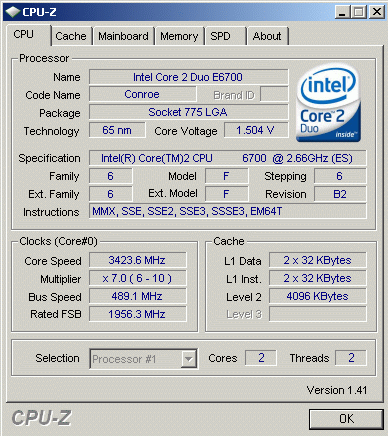
CPU-overclocking:
The drawback came with the maximum frequency. While this board was able to boot with 3730MHz, it was not able to run in the long term, because the temperatures were far too high. We needed 0.05V more VCore than with the DFI LANparty UT P35-T2R, so the core temperatures exceeded 70°C and stable operation was out of the question.
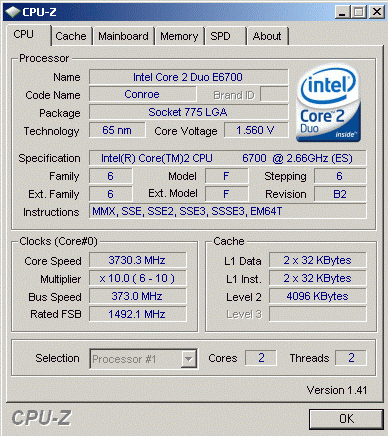
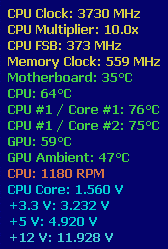
Memory-overclocking:
Some days ago we received our first PC3-14400 modules from Kingston, which will run at 900MHz (1800MHz). We feared we won't be able to run them on this board, because it's "standard," not "Deluxe" or "Maximus." Suprisingly, it was not a problem. You see the board runs them with 1T, so we let the board decide how to configure, we only set the main latencies to 8-8-8-24.
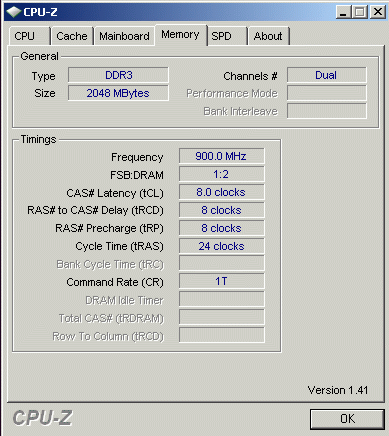
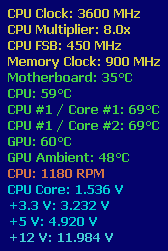
FSB BIOS clocking:
We have to state that we always recalculate the bench results to nominal frequencies. Most vendors do an overclock to their products, maybe to get more bench points, but we nullify such attempts. The P5E3 is overclocked with 266/333MHz, underclocked with 366MHz and on target with 320/400MHz:
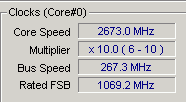

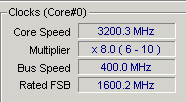
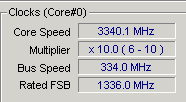
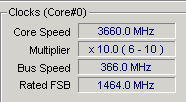
Testbed:
Motherboard:
ASUS P5E3 (provided by ASUS)
Intel X38/iCH9R
CPU:
Intel Core 2 Duo E6700 (provided by Intel)
CPU-Cooler:
Scythe Andy Samurai Master (provided by Scythe-Europe)
Memory:
Patriot 2GB Kit PC3-10666U PDC32G1333LLK (provided by Patriot)
CL7-7-7-20-CR2T at 1.50V
Kingston 2GB Kit PC3-14400U KHX14400D3K2/2G (provided by Kingston)
CL8-8-8-24 CR1T at 1.90V
Graphics Card:
AMD ATI Radeon X1950XTX (provided by AMD)
Power supply:
Silverstone Element SF50EF-Plus (provided by Silverstone)
Hard disk:
Western Digital WD4000KD (provided by Ditech)
Case fans:
SilenX iXtrema Pro 14dB(A) (provided by PC-Cooling.at)
Scythe DFS122512LS
Benchmarks:
Please note that different bios revisions may give different results. All benches are done with AUTO settings without altering any BIOS option besides CPU VCore, NB VCore and FSB Termination Voltage.
Gordian Knot/XVID 1.1.3:
For our Gordian Knot testing we took a PAL episode from "Babylon 5" with a length of 41 minutes, 57 seconds and 8 frames.
We tried to "emulate" the most common usage of Gordian Knot:
1st: We have a perfect master, so we only de-interlace the content and resize it without any other manipulations; we marked this as "fast."
2nd: You get bad mastering on many DVDs, especially "old" stuff or when the studios are in a hurry for the release. In this case you want to improve the picture quality, which is done by filtering the content. You can choose from lots of filters for any purposes you can think of, but we only used the most common "undot," "FluxSmooth" and "MSharpen." Of course, we also de-interlaced, filters were done before any resizing took place (which is slower). We marked this as "slow."
If you need more information about filters, we recommend reading the doom9.org forum.
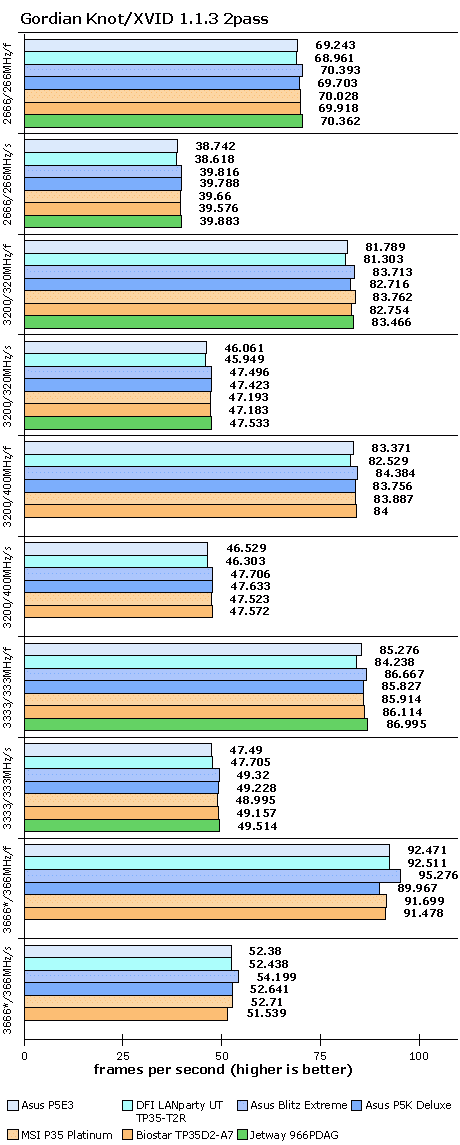
*Please note the Biostar board is running at 3600MHz.
x264:
x264 is a H.264/AVC codec which supports four threads and is available for free. We used the same "slow" settings as XviD. H.264 gives you a huge advantage in compressing size, and you need much less bitrate to achieve the same or better quality compared to XviD. While the H.264/AVC is much more advanced compared to MPEG2 encoders, now the CPU power is available to do the encoding in an acceptable time.
You can clearly see that a quad-core brings a massive advantage in encoding speed; the first pass seems to run on only two cores, but the second pass takes advantage of all four cores. With a quad-core you can nearly reach the speed of XivD, which can only use two cores for the time being.
The codec is open source, still in heavy development and you can grab it here.
Here DFI does not show any weakness, which is very strange, because video encoders should perform similarly.
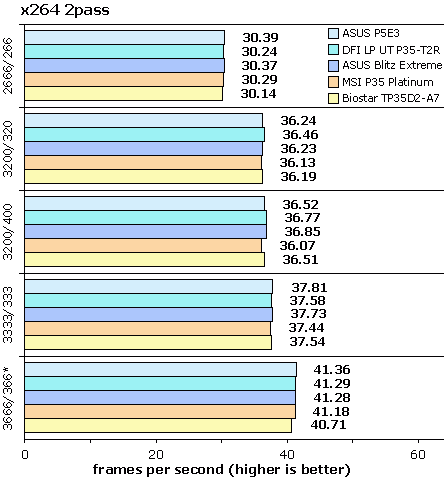
*Please note the Biostar board is running at 3600MHz.
LameMT:
The same episode we encoded, we used for our MP3-testing. We don't recommend using MP3 for encoding, because AC3 can do the job better, but nearly 42 minutes gives us approximately the length of any given album.
A measurement in seconds, as many sites do, is useless, because the differences are too small. So we used the built-in play/CPU ratio; this means the CPU is encoding x-times faster then the track-length. Fast memory does not play an important role here. For your convenience we also show you the single-threaded benches. They will be produced with any other L.A.M.E. version, because only LameMT can do more than one thread and take advantage of a second dice.
We used this setting: lamemt --vbr-new -q 2 -V 2 -m j --strictly-enforce-ISO --resample 48
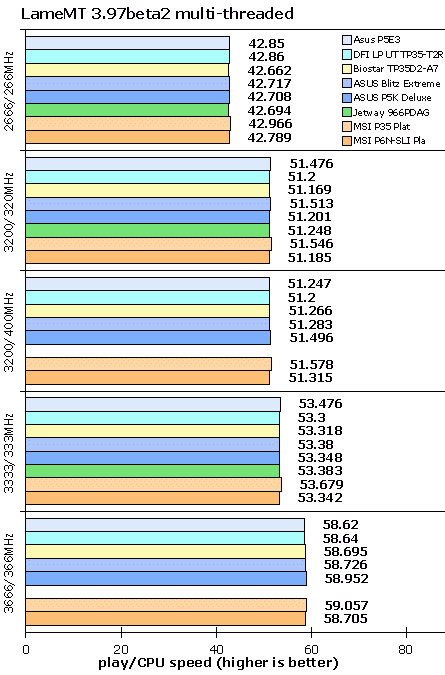

*Please note the Biostar board is calculated to 3666MHz, but runs at 3600MHz
Power-Consumption:
As mentioned in the BIOS section, the board suffers from not being able to reduce CPU VCore in idle mode when the CPU is overclocked, but the VRM is improved compared to any other ASUS board we tested so far. It's able to come close to DFI, but it failed when high overclocks were applied, because it needs +0.05V Vcore more than DFI to achive stable 3666MHz.
Please mention other configurations may yield other results.
Compared to DFI the latest ASUS board in our labs did exceptionally well, when not highly overclocked and comes close to the best results so far. Sadly, the VRM was not stable while overclocking to 3666MHz.
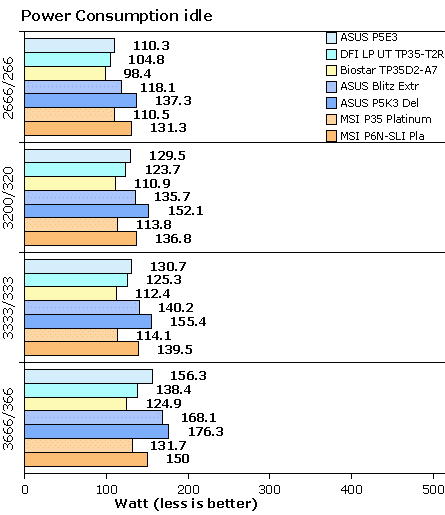
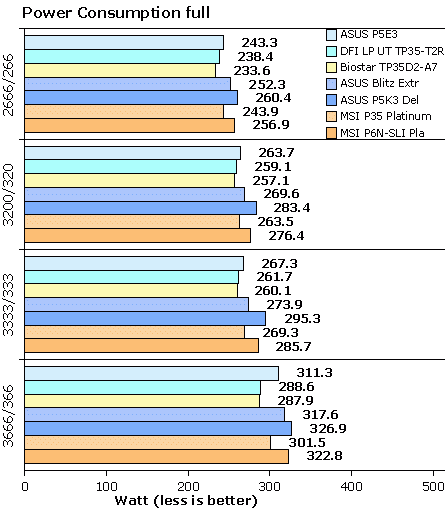
Conclusion:
ASUS has again made a huge step forward regarding the VRM design. This board is not a CPU overclocking board, we are not sure if the VRM or the P4 cpu-power connector holds it back at high frequencies where the VRM has to deliver massive amperes with stable voltage. A very good power-consumption result is ruined by the 3666MHz measurements. Another drawback is the exclusive usage of the PCIe x16 slots for graphics cards only. Some BIOS settings would have avoided such behavior.
On the plus side is stable operation, highly overclockable memory and FSB, the best power consumption an ASUS board ever got.
For us, this board is a mixed bag, not bad, but not as good, either. While a "standard" board, it's extraordinarily expensive, priced about €180,- and requiring very expensive DDR3 modules which will give you none to little advantage compared to DDR2. Besides the ASUS IR Remote, you will not receive any fancy extras.
If you spend some more money you can grab a DFI LANparty P35 board previously tested in our labs and if you wait two more weeks the DFI X38 boards should arrive and cost under €200,. Even ASUS is offering an high-end solution called "Maximus Formula" for under €200, too, which has a nicer layout, Supreme FX soundcard and other fancy stuff; we will tell you soon if it's worth the bucks.


